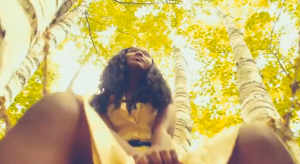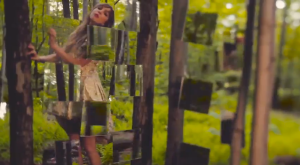So I’m kind of obsessed with The Mynabirds right now. My favorite song off their 2012 album is “Body of Work”:
(Lyrics + video link, in case embedding fails.)
After all our discussions about mainstream music culture and representations of gender therein, I started thinking about alternative sub-cultures and possible alternative narratives. I wondered if it could be found in the alternative/indie/underground musical scene. To me, The Mynabirds offers a “yes” to that question through political, self-aware artistry.
“‘Body of Work’ is a reminder of our absolute power to re-imagine, redesign and transform our lives at any given moment into something we enjoy to the utmost, something that’s wholly and fully our own,” says Mynabirds frontwoman Laura Burhenn. “We are not victims of the past, but artists who can shape it into the most brilliant form imaginable; we are living things, bodies of work to edit.”
[Source]
Critiquing culture often traps us in a negative spiral of picking apart every problematic. I fall into this trap quite often. Don’t get me wrong: it is supremely important work. But it is not everything; there should be room for finding positive examples, too. There are limits to looking, and there are burdens of responsibility on performers, viewers, and systems of looking — but there are also redemptive possibilities.
I’d like to offer a very cursory overview of what I love about “Body of Work”, in both its lyrics and the music video. Let’s start with a sampling of the lyrics:
You get so many lives in just this one
You’re not a knot, you’re not a dead end
Don’t ever forget
You’re a living thingBefore you lay down in this place
Remember you can see a blackbird
A thousand waysYou are a body of work — Edit it
“Freedom is what you do with what
With what’s been done to you”
The title and premise of the song echo the theories of ideology and identity performance we’ve been discussing. “You are a body of work” — we are constituted by narratives, interpellated by ideology, we perform ourselves as a ‘body of work’, which is read as identity. But as per Stuart Hall’s theory of articulation, it’s important to realize our agency in participation, via that performance. We can (re)negotiate the narratives constituting us. And there’s the Jean-Paul Sartre quote written into the lyrics: “freedom is what you do with what’s been done to you”. To me, that’s an understanding of freedom not as an absolute but as a constant negotiation of self. Forces act on us, from within and without, but the fact of living is the processing of those forces.
Looking plays a huge part in this song, through the lyrics — “remember you can see a blackbird / a thousand ways” (Wallace Stevens shout-out!) — and also in the music video. Mirrors, windows, cameras, and eyes are ubiquitous in the video; they very explicitly alert us to be aware of looking, and how we’re looking.

The video also plays on and undermines traditional ways of looking and representing women. In the early parts of the video, women gaze into mirrors and are reflected in them (0:46), but later, we see the mirror turned away and back onto the world. Rather than posing women as static bodies for the voyeuristic masculine gaze, the women of the video are dynamic. Women control the camera — explicitly, as in the woman holding a camera and taking a photo, which immediately cuts to a kaleidoscopically fragmented shot (0:23); and in the second half of the video, which is characterized by movement. Women (and men) dance and move, and the camera follows their movement not as a static gaze but as a part of that movement itself. This presents humans as actors, and invites us to re-imagine possibly being participants in that action, rather than just as viewers.

Throughout the video, the camerawork and the kaleidoscope fragmentation/rearrangement of images echoes the idea that there are other ways of looking. There’s a shot at 0:58, which is the traditional pan-up-from-below show so overused to sexualize women in mainstream music video. But here, it is attempting to be an explicitly non-sexual shot: we do not linger on her legs, crotch, or chest; the camera moves quickly to her face and upwards toward the sky.

The fragmentation of women’s bodies, as we discussed vv. “Dreamworlds 3”, is explicitly presented via the hanging mirrors in which Burhenn is reflected (0:32, 1:39). But this is also a subversive representation. The lyric at 0:32 is “sometimes you’re an avalanche in whole” [my emphasis]; the lyric at 1:39 is “you can see a blackbird a thousand ways”. The overall effect is to invite us to reconsider the narrative, and find new ways of negotiating our viewing and understanding.

Also, the video plays upon the traditional image of woman & mirror at 1:49 and 2:42. The first shot is that classic image of a woman holding up a mirror and looking into it. In the second, the mirror in her hands is now pointed toward the sky; the angle of her looking would mean she is seeing the sky, not herself. And then, very clearly, we see her look away from the mirror and straight into the camera — at us. The tables have turned.

Similarly, Burhenn is shown looking into a telescope at 1:27, accompanied by the lyric: “freedom is what you do with what’s been done to you”. Here she, an object of our viewing, demonstrates her own looking at the world.

The video also invites us to shift our frame of reference, e.g. at 0:47 with a shot of the woman seemingly “trapped” behind a window, which then cuts to a wide shot showing she is actually the one holding up the window.
***
I do question the ahistorical agency that Burhenn claims in such uncomplicated terms. For example, how do we negotiate this kind of living re-writing against the structures of thinking and ideology that haunt our very imagining? And we must, because disavowal leads us back into that which we would escape. Also the video is problematic in only representing normative bodies while trying to deliver an empowering message of freedom. At the same time, though, there are limits to representation: if we accept that we are, indeed, a body of work, then we must understand we are not merely the (misidentified) image in the mirror, but a complex interaction of narratives and performance, and the infinite mind and language are inherently unrepresentable and untranslatable.
But I still love this song. The appeal to creative thought and to the infinity of our minds is a powerful hope. It may prove ultimately delusional, if taken to be a utopian vision of wholeness, but I think the point is that we can (and do) constantly re-negotiate our identities, even if our negotiation happens within certain structures; that there are so many ways of looking, some (many) of them violent and oppressive, but that in the fact of multiplicity itself resides possibility; and that living means a temporal existence that is moment-by-moment change.




